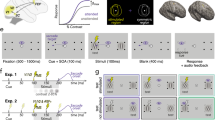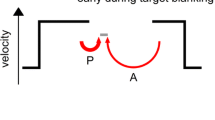Summary
The study initially explored the frontal eye field's (FEF) control of predictive eye movements, i.e., eye movements driven by previous rather than current sensory signals. Five monkeys were trained to pursue horizontal target motion, including sinusoidal targets and “random-walk” targets which sometimes deviated from a sine motion. Some subjects also tracked other target trajectories and optokinetic motion. FEF ablations or cold lesions impaired predictive pursuit, but also degraded visually guided foveal pursuit of all targets. Unilateral lesions impaired pursuit of targets moving in both horizontal orbital fields and in both directions of movement. Saccadic estimates of target motion were generally accurate. The slow-phase velocity of optokinetic pursuit (collected after 54 s of OKN) also appeared normal. Pursuit recovered over 1–3 weeks after surgery but the deficits were then reinstated by removal of FEF in the other hemisphere. Thereafter, a slight deficit persisted for up to 10 weeks of observation in two subjects. The pattern of symptoms suggests that FEF lies subsequent to parietal area MST and prior to the pontine nuclei in controlling pursuit eye movements.
Similar content being viewed by others
References
Andersen RA (1989) Visual and eye movement functions of the posterior parietal cortex. Ann Rev Neurosci 12:377–403
Andersen RA, Asanuma C, Cowan WM (1985) Callosal and prefrontal associational projecting cell populations in area 7a of the macaque monkey: a study using retrogradely transported fluorescent dyes. J Comp Neurol 232:443–458
Bahill AT, McDonald JD (1983) Model emulates human smooth pursuit system producing zero-latency target tracking. Biol Cybern 48:213–222
Becker W, Fuchs AF (1985) Prediction in the oculomotor system: smooth pursuit during transient disappearance of a visual target. Exp Brain Res 57:562–575
Benita M, Conde H (1972) Effects of local cooling upon conduction and synaptic transmission. Brain Res 36:133–151
Bizzi E (1968) Discharge of frontal eye field neurons during saccadic and following eye movements in unanesthetized monkeys. Exp Brain Res 6:69–80
Brace CJ, Goldberg ME (1985) Primate frontal eye fields. I. Single neurons discharging before saccades. J Neurophysiol 53:603–635
Bruce CJ, Goldberg ME, Bushnell MC, Stanton GB (1985) Primate frontal eye fields. II. Physiological and anatomical correlates of electrically evoked eye movements. J Neurophysiol 54:714–734
Cassell KJ (1973) The usefulness of a temporal correlation technique in the assessment of human motor performance on a tracking device. Med Biol Eng Comput 11:755–761
Cohen B, Matsuo V, Raphan T (1977) Quantitative analysis of the velocity characteristics of optokinetic nystagmus and optokinetic after-nystagmus. J Physiol 270:321–344
Crowne DP (1983) The frontal eye field and attention. Psychol Bull 93:232–260
Deng SY, Segraves MA, Ungerleider LG, Mishkin M, Goldberg ME (1984) Unilateral frontal eye field lesions degrade saccadic performance in the rhesus monkey. Abstr Soc Neurosci 10:59
Dursteler MR, Wurtz RH (1988) Pursuit and optokinetic deficits following chemical lesions of cortical areas MT and MST. J Neurophysiol 60:940–965
Eckmiller R, Mackeben M (1978) Pursuit eye movements and their neural control in the monkey. Pflugers Arch 337:15–23
Ferrier D (1874) The localization of function in the brain. Proc R Soc C 22:229–232
Goldberg ME, Bruce CJ (1990) Primate frontal eye fields. III. Maintenance of a spatially accurate saccade signal. J Neuro-physiol 64:489–508
Gottlieb JP, MacAvoy MG, Bruce CJ (1989) Unit activity related to smooth pursuit eye movements in rhesus monkey frontal eye fields. Abstr Soc Neurosci 15:1203
Guitton D, Buchtel HA, Douglas RM (1985) Frontal lobe lesions in man cause difficulties in suppressing reflexive glances and in generating goal-directed saccades. Exp Brain Res 58:455–472
Holmes G (1938) The cerebral integration of the ocular movements. Br Med J 2:107–112
Horel JA (1984) Cold lesions in inferotemporal cortex produce reversible deficits in learning and retention of visual discriminations. Physiol Psychol 12:259–270
Huerta MF, Krubitzer LA, Kaas JH (1986) Frontal eye field as defined by intracortical microstimulation in squirrel monkeys, owl monkeys, and macaque monkeys: I. Subcortical connections. J Comp Neurol 253:415–439
Ingelfinger JA, Mosteller F, Thibodeau LA, Ware JH (1983) Bio-statistics in Clinical Medicine. Macmillan, New York
Kato I, Harada K, Hasegawa T, Igarashi T, Koike Y, Kawasaki T (1986) Role of the nucleus of the optic tract in monkeys in relation to optokinetic nystagmus. Brain Res 364:12–22
Keating EG, Gooley SG (1988) Saccadic disorders caused by cooling the superior colliculus or the frontal eye field, or from combined lesions of both structures. Brain Res 438:247–255
Keating EG, Gooley SG, Kenney DV (1985) Impaired tracking and loss of predictive eye movements after removal of the frontal eye fields. Abstr Soc Neurosci 11:472
Leichnetz GR (1989) Inferior frontal eye field projections to the pursuit-related dorsolateral pontine and middle temporal area (MT) in the monkey. Vis Neurosci 3:171–180
Lisberger SG, Westbrook LE (1985) Properties of visual inputs that initiate horizontal smooth pursuit eye movements in monkeys. J Neurosci 5:1662–1673
Lisberger SG, Evinger C, Johanson GW, Fuchs AF (1981) Relationship between eye acceleration and retinal image velocity during foveal smooth pursuit in man and monkey. J Neurophysiol 46:229–249
Luria AR, Karpov BA, Yarbuss AL (1966) Disturbances of active visual perception with lesions of the frontal lobes. Cortex 2:202–212
Lynch JC (1987) Frontal eye field lesions in monkeys disrupt visual pursuit. Exp Brain Res 68:437–441
Lynch JC, Allison JC (1985) A quantitative study of visual pursuit deficits following lesions of the frontal eye fields in rhesus monkeys. Abstr Soc Neurosci 11:473
MacAvoy MG, Bruce CJ (1989) Oculomotor deficits associated with lesions of the frontal eye field area in macaque monkeys. Abstr Soc Neurosci 15:1203
May JG, Keller EL, Suzuki DA (1988) Smooth-pursuit eye movement deficits with chemical lesions in the dorsolateral pontine nucleus of the monkey. J Neurophysiol 59:952–977
Morris EJ, Lisberger SG (1989) Predictive and visually-driven components of sinusoidal smooth pursuit eye movements. Abstr Soc Neurosci 15:1205
Newsome WT, Wurtz RH, Dursteler MR, Mikami A (1985a) Deficits in visual motion processing following ibotenic acid lesions of the middle temporal visual area of the macaque monkey. J Neurosci 5:825–840
Newsome WT, Wurtz RH, Dursteler MR, Mikami A (1985b) Punctate chemical lesions of striate cortex in the macaque monkey: effect on visually guided saccades. Exp Brain Res 58:392–399
Robinson DA, Fuchs AF (1969) Eye movements evoked by stimulation of frontal eye fields. J Neurophysiol 32:637–648
Schiller PH, True SD, Conway JL (1980) Deficits in eye movements following frontal eye-field and superior colliculus ablations. J Neurophysiol 44:1175–1189
Stanton GB, Goldberg ME, Bruce CJ (1988b) Frontal eye field efferents in the Macaque monkey: II. Topography of terminal fields in midbrain and pons. J Comp Neurol 271:493–506
Van den Berg AV (1989) Human smooth pursuit during transient perturbations of predictable and unpredictable target movement. Exp Brain Res 72:95–108
Walker AE (1940) A cytoarchitectural study of the prefrontal area of the macaque monkey. J Comp Neurol 73:59–86
Zee DS, Tusa RJ, Herdman SJ, Butler PH, Gucer G (1987) Effects of occipital lobectomy upon eye movements in primate. J Neurophysiol 58:883–907
Author information
Authors and Affiliations
Rights and permissions
About this article
Cite this article
Keating, E.G. Frontal eye field lesions impair predictive and visually-guided pursuit eye movements. Exp Brain Res 86, 311–323 (1991). https://doi.org/10.1007/BF00228954
Received:
Accepted:
Issue Date:
DOI: https://doi.org/10.1007/BF00228954




